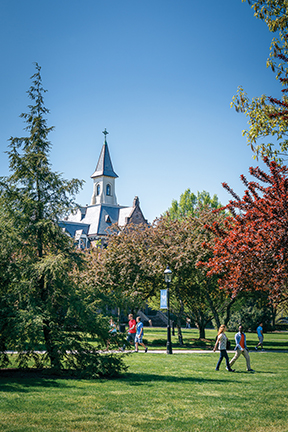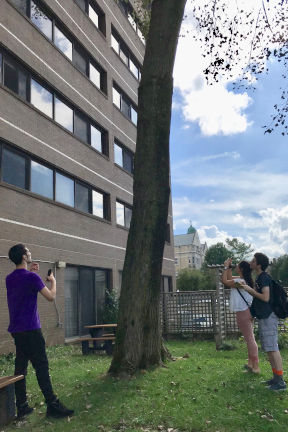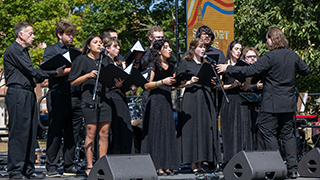Great Minds Go Green with Tree Inventory Project
Thursday, May 9th, 2019

More than 50 students in the Introduction to Environmental Studies and Permaculture Design courses participated in the tree inventory project in collaboration with the South Orange Environmental Commission. The project, which started in September 2018, will take many semesters to complete and a new set of students will contribute to the project each semester.
Planting Seeds
The project started out with students learning about the diversity of trees on campus,
identifying over 900 trees. They entered information about the trees into a cloud-based
GIS software for data aggregation and analysis. The project then grew in size and
scope by collaborating with the South Orange Environmental Commission to use the same
software to house over 10,000 public trees in South Orange.
The project started when Wanda Knapik, an instructor in the Environmental Studies program in the College of Arts of Sciences, began teaching her students about the value of trees in storing carbon and reversing global warming. To help students gain an appreciation for the natural beauty on campus and the eco-benefits of the diversity of trees, she partnered with the campus grounds crew and the Facilities Engineering Department to start creating the campus tree inventory.
The students were tasked with identifying, measuring and entering data on the trees into Tree Plotter, the software system that stores, analyzes and displays data on the location, description and maintenance requirements of the trees. The software also calculates the eco-benefits of the trees and displays their value in cleaning the air, managing storm water runoff, providing habitat for wildlife and cooling temperatures on campus. This data, in turn, will provide the grounds crew with the necessary information right at their fingertips in the event the trees are damaged by severe weather or just need maintenance.
Jeff Truskowski, Director of Grounds, said in a previous story, "We have a wide variety of trees on campus, many different species and hundreds need pruning and maintenance. Having the students enter the tree data and create a consolidated tree inventory is a huge help."
Branching Out

Years ago, the town had its inventory on paper but lost the records in a flood, so it needed to start from scratch and re-create the inventory of its 10,000 public street trees.
Knapik said the electronic inventory of trees will help South Orange better manage and maintain their public trees as well as identify areas to plant more trees. The tree data can also be used in grant applications to obtain funding for treating and protecting the ash trees. Healthy trees also increase property values.
"Having this data aggregated is a powerful insight into the value the trees are giving to the community," Knapik said. "They do a lot more than we think, as they help us ecologically and provide us with beauty, comfort and healing qualities. We also need more trees to help manage storm water runoff—the more trees we have, the less storm water runoff we'll have as well."
Making a Bigger Impact

Helan Thomas, a junior biology and environmental studies major, has been working on the project with Knapik since it launched and described the project as "exciting."
"It has been really exciting working with the South Orange Environmental Commission and going through the logistics of such a large project," Thomas said. "We are learning how to work together as a team. We collaborate on plotting the trees, identifying them and delegating tasks."
Growing Together
In all the classes she teaches, Knapik said she focuses on hands-on learning and practical
application of classroom material in real-world situations. There are many environmental
challenges in the world today and many opportunities for students to use their creative
problem-solving skills, work individually and collaborate with others.
"Working in groups is an important element in solving the climate crisis together," Knapik said. "Collaboration is needed more than competition in the world today. We need to work together to reverse global warming and implement many solutions quickly. There are no passengers on Spaceship Earth—we are all crew."

Thomas, who currently takes Knapik's Permaculture Design class, said, "It has been great to see the many benefits the trees bring to us. If you're interested in learning how to mesh agriculture with culture, how to design and maximize a plot of land or even to just turn your thumb green, I recommend taking this class."
Knapik said most importantly, the students are discovering how to be good stewards of the earth, how everything is interconnected in the web of life and how they can make a difference in creating a future where nature isn't destroyed—it thrives.
"To solve this environmental crisis, we all have to do the best we can in whatever capacity is possible in this moment" she said. "We have to care for our common home. That's the purpose of this whole project: to connect students' minds to their hearts so they act with love and compassion for all beings on Earth."
Learn more about What Great Minds Can Do in helping save the environment »






